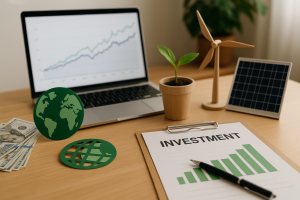Investing isn’t just about profit anymore—it’s about purpose and long-term responsibility. As environmental challenges grow more urgent, more investors are turning to strategies that make a measurable difference. Environmental impact finance is leading this shift, blending financial returns with real-world environmental outcomes that matter long after a trade is made or a portfolio is built.
This type of investing prioritizes companies and projects that actively reduce emissions, preserve resources, and promote renewable solutions worldwide. Whether you’re new to investing or rethinking your portfolio’s direction, aligning your money with sustainability goals is one of the most effective and empowering ways to influence change and support lasting environmental progress.
What is environmental impact finance?

Environmental impact finance refers to investment strategies focused on generating positive environmental outcomes alongside financial returns. These investments often target renewable energy, sustainable agriculture, conservation, clean technology, and businesses with strong ESG (Environmental, Social, Governance) practices. The goal is to use capital as a catalyst for climate resilience and resource protection.
Unlike traditional investing, where performance is measured solely in dollars, impact finance also evaluates results like reduced carbon footprints, water conservation, or biodiversity preservation. It’s about ensuring your investments support the planet—not just your bottom line.
Impact finance moves the needle
When enough investors redirect their funds toward sustainability, entire industries shift. Impact finance doesn’t just reward responsible businesses—it pressures others to improve. This approach strengthens long-term market trends, attracts responsible investors, and reinforces global sustainability efforts.
Why investors are embracing sustainability
Environmental awareness is no longer niche—it’s mainstream and deeply personal. From wildfires and floods to water shortages and supply chain disruptions, climate change is now affecting daily life. That growing reality has prompted investors to look for opportunities that offer resilience and responsibility—not just short-term growth.
Environmental impact finance responds to this demand with meaningful solutions. It offers a way to support sustainable development while tapping into growing markets and forward-looking business models. As governments and corporations transition to greener operations, investors are finding consistent performance in companies focused on clean energy, low-emission strategies, and transparent governance practices.
| Reason to Invest Sustainably | Environmental Impact | Financial Benefit |
|---|---|---|
| Climate Risk Mitigation | Reduced emissions | Future-proofed portfolios |
| Resource Efficiency | Water & energy saved | Operational cost reductions |
| ESG Transparency | Better governance | Lower regulatory risk |
| Innovation in Clean Tech | Renewable adoption | Long-term market growth potential |
| Brand Reputation & Public Trust | Positive image | Increased consumer and investor appeal |
How to get started with impact investing
If you’re ready to align your portfolio with your values, the good news is: you don’t need to overhaul everything to make a meaningful change. Environmental impact finance comes in many forms—from individual green stocks and mutual funds to bonds and exchange-traded funds (ETFs) focused on sustainability and corporate responsibility.
Start by identifying your priorities. Are you passionate about clean water? Renewable energy? Reducing plastic pollution or supporting ethical supply chains? Then look for investment vehicles that support those missions clearly. Many platforms now offer ESG or green-certified portfolios, making it easier than ever to put your money where your values are.
Start small, scale up
You don’t need to be a millionaire to invest sustainably. Even a modest investment, done intentionally, helps shift demand toward cleaner business practices. This approach strengthens long-term market trends, attracts responsible investors, and reinforces global sustainability efforts.
Understanding the metrics behind impact
A key element of environmental impact finance is transparency. Investors need to know not just where their money goes, but what it’s accomplishing and whether it’s generating actual results. That’s where frameworks like ESG ratings, carbon intensity scores, and impact reporting come in to guide more informed decisions.
These tools allow you to compare companies not just on revenue growth, but on how they treat the planet. The stronger the data, the more confident you can be that your investment is making a measurable difference—not just ticking a green box without substance or accountability.
| Metric Type | What It Measures | Why It Matters |
| ESG Score | Environmental, social & governance risk | Indicates long-term sustainability |
| Carbon Footprint | Emissions per revenue unit | Reveals climate impact of operations |
| Water Usage Efficiency | Water consumption relative to output | Shows resource conservation performance |
| Sustainable Revenue | % from green products/services | Tracks company focus on clean markets |
| Impact Reports | Real-world outcomes (e.g., CO₂ saved) | Verifies environmental benefits |
Challenges and misconceptions about impact finance
Like any movement, environmental impact finance faces skepticism. Some assume it means lower returns or fewer investment options. Others worry about greenwashing—when companies claim to be eco-friendly without backing it up with data. These are real concerns, but they’re not reasons to avoid the space.
As demand increases, so do regulation and reporting standards. Today, investors can access stronger data, clearer disclosures, and more third-party certifications. And from a performance perspective, many sustainable funds have matched—or even outperformed—traditional portfolios, especially over the long term, proving that purpose and profit can go hand in hand.
The myth that green means weak
You don’t have to sacrifice performance to invest with purpose. In fact, sustainability often signals smarter, future-ready companies. This approach strengthens long-term market trends, attracts responsible investors, and reinforces global sustainability efforts.
The bigger picture: how impact finance supports global goals
Impact finance doesn’t just benefit individual portfolios—it supports broader global efforts, including the United Nations Sustainable Development Goals (SDGs). When you invest in environmental impact finance, you help fund climate solutions, clean water projects, sustainable infrastructure, green innovation, and more community-driven initiatives.
Each dollar you invest sends a message: that sustainability is not optional—it’s essential. And when millions of investors make similar choices, capital begins to flow toward systems that prioritize innovation, resilience, and ecological balance. That’s the kind of impact that extends well beyond returns—it lays the groundwork for a healthier, more sustainable future.
Investing Is a Form of Advocacy
Your investment decisions have real and lasting power. By choosing sustainability, you actively contribute to meaningful progress—quietly, steadily, and with purpose. This mindset helps shape a more responsible financial system, attracts like-minded investors, and reinforces global momentum toward long-term environmental change.



